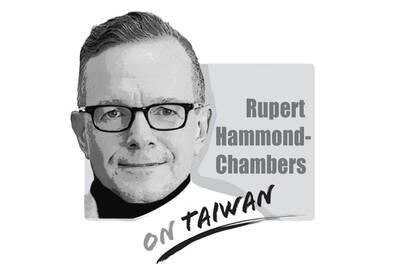Last month, China announced that effective Aug. 1, it was banning independent travel to Taiwan, citing the current state of cross-strait relations. Beijing hopes that by harming the nation’s tourism industry, it could gain leverage over Taiwanese politics.
I am a resident of Tainan, one of the nation’s tourism hotspots. In response to Beijing’s move, Tainan Deputy Mayor Wang Shih-ssu (王時思) on Tuesday last week launched the initiative “Free tourism in a free nation.”
Wang called on netizens to post images and stories that display the beauty of Taiwan to stimulate domestic tourism and to contrast unencumbered travel in Taiwan with the restrictive nature of tourism in China.
LOCALIZATION
Beijing’s arbitrary restriction not only places political considerations above the individual liberty of Chinese citizens, but is also a clandestine attack on Taiwan’s localist political parties.
However, should people also be concerned about the potential effect this could have on the tourism industry and the wider economy? The short answer is no.
Last year, 3.53 million people rented accommodation in Tainan. About 100,000 were Chinese, constituting just 2.8 percent. This shows that the overall contribution of Chinese travelers to Tainan’s tourism sector is limited.
Furthermore, Beijing’s clumsy “united front” tactic is just the latest in a long line of examples.
After Taiwanese made the “wrong” decision in the 2016 presidential and legislative elections, Beijing initiated a “united front” strategy that offered special travel packages to encourage Chinese to visit the eight municipalities and counties where the incumbent mayor or commissioner was a pan-blue politician who recognized the so-called “1992 consensus.”
A propaganda poster developed by China at the time, emblazoned with the slogan “1992 consensus: Making people’s lives better,” now looks richly ironic.
Although Beijing vociferously promoted a policy of “differential treatment” in 2016, there was no visible effect on Tainan’s tourism industry.
In 2015, Tainan’s main tourism hotspots attracted 23 million visitors. In 2016, that number dropped by 1 million, but the following year, it returned to 23 million.
TAINAN MODEL
Tainan’s tourism industry has been incredibly resilient in the face of multiple attacks by Beijing. Built on solid foundations, Tainan is a paragon of self-
sufficient tourism and a model for the rest of the nation.
Tainan residents, responding to the latest restriction on social media, have even boasted that their city does not need to rely on Chinese tourists.
How is it that Tainan’s tourism industry has been able to weather the storm? Many young Hong Kongers, unable to bear Beijing’s repressive rule, have been emigrating to Taiwan, and for many, their first choice is to settle in Tainan.
In addition to the old-world charm of Tainan’s historic center, Hong Kongers are also attracted to the warmth and friendliness of its residents.
Perhaps most of all, there is an indomitable spirit of defiance and freedom that permeates the city.
If Taiwan preserves its unique characteristics, exudes self-confidence and individuality, and above all protects its democratic and liberal values, this will be the most effective defense against the slings and arrows of China’s dictatorship.
Lin Cheng-you is chief secretary of the Taiwan Statebuilding Party’s Tainan branch.
Translated by Edward Jones

In the past month, two important developments are poised to equip Taiwan with expanded capabilities to play foreign policy offense in an age where Taiwan’s diplomatic space is seriously constricted by a hegemonic Beijing. Taiwan Foreign Minister Lin Chia-lung (林佳龍) led a delegation of Taiwan and US companies to the Philippines to promote trilateral economic cooperation between the three countries. Additionally, in the past two weeks, Taiwan has placed chip export controls on South Africa in an escalating standoff over the placing of its diplomatic mission in Pretoria, causing the South Africans to pause and ask for consultations to resolve
An altercation involving a 73-year-old woman and a younger person broke out on a Taipei MRT train last week, with videos of the incident going viral online, sparking wide discussions about the controversial priority seats and social norms. In the video, the elderly woman, surnamed Tseng (曾), approached a passenger in a priority seat and demanded that she get up, and after she refused, she swung her bag, hitting her on the knees and calves several times. In return, the commuter asked a nearby passenger to hold her bag, stood up and kicked Tseng, causing her to fall backward and
In December 1937, Japanese troops captured Nanjing and unleashed one of the darkest chapters of the 20th century. Over six weeks, hundreds of thousands were slaughtered and women were raped on a scale that still defies comprehension. Across Asia, the Japanese occupation left deep scars. Singapore, Malaya, the Philippines and much of China endured terror, forced labor and massacres. My own grandfather was tortured by the Japanese in Singapore. His wife, traumatized beyond recovery, lived the rest of her life in silence and breakdown. These stories are real, not abstract history. Here is the irony: Mao Zedong (毛澤東) himself once told visiting
When I reminded my 83-year-old mother on Wednesday that it was the 76th anniversary of the founding of the People’s Republic of China, she replied: “Yes, it was the day when my family was broken.” That answer captures the paradox of modern China. To most Chinese in mainland China, Oct. 1 is a day of pride — a celebration of national strength, prosperity and global stature. However, on a deeper level, it is also a reminder to many of the families shattered, the freedoms extinguished and the lives sacrificed on the road here. Seventy-six years ago, Chinese Communist leader Mao Zedong (毛澤東)